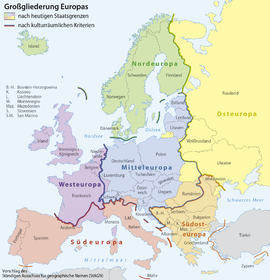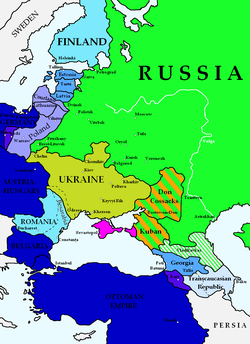- Mitteleuropa
-
This article is about (1) a historical concept in ninenteenth-century Germany and (2) the different use of the same word in modern Germany. For (3) the equivalent geographical concept in the English-speaking world, see Central Europe.
Mitteleuropa is the German term equal to Central Europe.[1] The word has political, geographic and cultural meaning.[2] While it describes a geographical location, it also is the word denoting a political concept of a German-dominated and exploited Central European union that was put into motion during First World War. The historian Jörg Brechtefeld describes 'Mitteleuropa' as the following:
The term 'Mitteleuropa' never has been merely a geographical term; it is also a political one, much as Europe, East and West, are terms that political scientists employ as synonyms for political ideas or concepts. Traditionally, Mitteleuropa has been that part of Europa between East and West. As profane as this may sound, this is probably the most precise definition of Mitteleuropa available.[3]
Contents
Geography
 States of Mitteleuropa (blue) and the larger cultural sphere (outlined) that in the late 19th century comprised the German Empire, Austria-Hungary, Switzerland, as well as Congress Poland and the Baltic governorates of the Russian Empire
States of Mitteleuropa (blue) and the larger cultural sphere (outlined) that in the late 19th century comprised the German Empire, Austria-Hungary, Switzerland, as well as Congress Poland and the Baltic governorates of the Russian Empire
The German academic Ständiger Ausschuss für geographische Namen (Permanent Committee on Geographical Names) at the Federal Agency for Cartography and Geodesy refers to a territory roughly bounded by the river Rhine in the west, the Bug in the east, the North Sea and the Baltic coast in the north, as well as the Alps and the Adriatic Sea in the south. The area is covered by the modern states of:
Baltic states (Baltikum):
Mitteleuropa construed as a cultural area would further include:
- Alsace and the Moselle département of northern Lorraine in
 France
France  Luxembourg, though usually referred to as a West European country
Luxembourg, though usually referred to as a West European country- the Kaliningrad Oblast exclave of
 Russia
Russia - the eastern Vilnius Region in
 Belarus
Belarus - territories of former Austria-Hungary in
 Italy – Trentino-Alto Adige/Südtirol and the area of the former Austrian Littoral in eastern Friuli and Trieste
Italy – Trentino-Alto Adige/Südtirol and the area of the former Austrian Littoral in eastern Friuli and Trieste Serbia – Vojvodina, Belgrade, Mačva regions
Serbia – Vojvodina, Belgrade, Mačva regions Romania – Transylvania (Siebenbürgen) and southern Bukovina
Romania – Transylvania (Siebenbürgen) and southern Bukovina Ukraine – eastern Galicia, Carpathian Ruthenia and northern Bukovina
Ukraine – eastern Galicia, Carpathian Ruthenia and northern Bukovina
Conceptual history
At the time when the 500 years long Ostsiedlung process was stopped by the Black Death in the mid 14th century, Germans had settled the "Wendish" Central European areas of Germania Slavica far beyond the Elbe and Saale rivers. They had moved along the Baltic coast from Holstein to Farther Pomerania, up the Oder river to the Moravian Gate, down the Danube into the Kingdom of Hungary and to the Slovene lands of Carniola. From the mouth of the Vistula river and the Prussian region, the Teutonic Knights by force continued the eastward migration up to Estonian Reval (Tallinn), Germans also settled in the mountainous border regions of Bohemia and Moravia and formed a distinct social class of citizens in towns like Prague, Havlíčkův Brod (Deutsch-Brod), Olomouc (Olmütz) and Brno (Brünn). They had moved into the Polish Kraków Voivodeship, the Western Carpathians and Transylvania (Siebenbürgen), introducing the crop rotation practice and German town law.
In the course of the Black Death, widespread pogroms against Jews from 1348 occurred in the German Rhineland, causing an emigration in huge numbers to the Kingdom of Poland under Casimir the Great and to the Grand Duchy of Lithuania under Vytautas granting them extensive privileges. The Ashkenazi expellees and their High German Yiddish language left a significant imprint on Eastern Central Europe, in towns like Lviv (Lemberg), Lublin, Minsk and Chernivtsi (Czernowitz), but also in the Bohemian capital Prague as well as in numerous shtetls. The rabbis at first received their religious education at German yeshivot. During the Age of Enlightenment, the Jewish Haskalah movement pursueing emancipation orientated itself by German protagonists like Moses Mendelssohn as in the Prussian lands under Frederick the Great, so-called Schutzjuden were able to live under the circumstances of a limited religious tolerance. With the increasing persecutions from the 1648 Khmelnytsky Uprising onwards, especially the 19th century Anti-Jewish pogroms in the Russian Empire, the approach to Germany was heightened. The Jewish Mitteleuropa culture was erased in The Holocaust.
Upon the dissolution of the Holy Roman Empire in 1806 and the formation of the Concert of Europe after the Napoleonic Wars, the Romantic writer Constantin Frantz during the Vormärz era developed the concept of a Central European federation overcoming the German dualism between Austria and Prussia. Frantz opposed the idea of a nation state as it was raised by the German question and advocated a commonwealth of the member states of the former Confederation of the Rhine together with the Austrian multiethnic state and Prussia with its large Polish share of population. This Central European block should have been joined by Belgium, the Netherlands and Switzerland as well as by Congress Poland, seeking autonomy from the hegemony of the great powers of France and the British Empire in the west as well as from the Pan-Slav policies of the Russian Empire in the east.
After the Revolutions of 1848 these ideas were adpoted by liberal theorists like Friedrich List and Heinrich von Gagern, later by the German National Liberal Party, then however with a distinct Pan-German notion and accompanied by the concept of a renewed settler colonialism under the firm leadership of the German Empire and Austria-Hungary. Upon the 1871 Unification of Germany under Chancellor Otto von Bismarck, the Ostforschung concentrated on the achievements by Ethnic Germans in East-Central Europe on the basis of Ethnocentrism with significant anti-Slavic, especially anti-Polish notions, as propagated by the Pan-German League. Meanwhile Austria had to abandon her claim to leadership and thereafter referred Mitteleuropa to the lands of the Habsburg Monarchy in the Danube basin.
Mitteleuropa Plan
Map of German plans for a new political order in Central and Eastern Europe after the Treaty of Brest-Litovsk of February 9, 1918, Treaty of Brest-Litovsk of March 3, 1918 and Treaty of Bucharest of May 7, 1918. Germany and its alliesAreas of Russian parts of Poland and Armenia to be annexed by Germany/TurkeySemi-autonomous states under full German control – planned annexationNew countries – economically and administratively dependent on GermanyUkraine – under German economic controlPlanned Tatar Republic – area of German colonizationCountries politically and economically tied with GermanyPlanned Transcaucasian Republic – politically tied with GermanySemi-autonomous Cossack states inside Russia – German sphere of influence
Germany and its alliesAreas of Russian parts of Poland and Armenia to be annexed by Germany/TurkeySemi-autonomous states under full German control – planned annexationNew countries – economically and administratively dependent on GermanyUkraine – under German economic controlPlanned Tatar Republic – area of German colonizationCountries politically and economically tied with GermanyPlanned Transcaucasian Republic – politically tied with GermanySemi-autonomous Cossack states inside Russia – German sphere of influenceThe Mitteleuropa plan was to achieve an economic and cultural hegemony over Central Europe by the German Empire[4][5] and subsequent economic & financial exploitation[6][7]of this region combined with direct annexations[6], settlement of German colonists, expulsion of non-Germans from annexed areas, and eventual Germanization of puppet states created as a buffer between Germany and Russia. The issue of Central Europe was taken by German thinker Friedrich Naumann in 1915 in his work Mitteleuropa. According to his thought, this part of Europe was to become a politically and economically integrated block subjected to German rule. In his program, Naumann also supported programs of Germanization and Hungarization as well.[8] Naumann in his book used imperialist rhetoric combined with praises to nature, and imperial condescension towards non-German people, while advising to show some "flexbility" towards non-German languages to achieve "harmony"[9]Neuman wrote that it would stabilize the whole Central Europe region. See[10] Some parts of the planning included designs on creating a German colony in Crimea and colonization of the Baltic states.[11]
The ruling political elites of Germany accepted the Mitteleuropa plan during World War I while drawing out German war aims and plans for the new order of Europe.[8] Mitteleuropa was to be created by establishing a series of puppet states whose political, economic and military aspects would be under the control of the German Reich.[12] The entire region was to serve as an economic backyard of Germany whose exploitation would enable it to compete with the British Empire and any other competitors for the position of the world's dominant power.[12] Political, military and economic organization was to be based on German domination[13], with commercial treaties imposed on countries like Poland and Ukraine. It was believed that the German working classes could be appeased by German politicians through the economic benefits of territorial annexation, settlement of Germans in Central and Eastern Europe and exploitation of conquered countries for the material benefit of Germany.[14]
Partial realization of these plans was reflected in the Treaty of Brest-Litovsk, where guarantees of economic and military domination over Ukraine by Germany were laid out.[15] Both Ottoman Empire and Austro-Hungary would become reliant on German support in post-war Europe,reducing them to the status of vassals[16]
The Mitteleuropa plan was viewed as threat by the British Empire, which concluded it would destroy British continental trade, and as consequence the source of its military power[17]
See also
- Central Europe
- Lebensraum
- Drang nach Osten
- Geographical centre of Europe
- League of East European States
References
- ^ LEO Ergebnisse für "Mitteleuropa"
- ^ Jan Wendt "Współpraca regionalna Polski w Europie Środkowej" Centrum Europejskie University of Warsaw, Studia Europejskie, nr 4/1998
- ^ J. Brechtefeld, Mitteleuropa and German politics. 1848 to the present (London 1996)
- ^ A history of eastern Europe: crisis and change Robert Bideleux,Ian Jeffries, page 12,Routledge 1998
- ^ The Challenge of Hegemony: Grand Strategy, Trade, and Domestic Politics Steven E. Lobell, page 52, University of Michigan Press
- ^ a b "War and Punishment: The Causes of War Termination and the First World War" Hein Erich Goemans, Princeton University, page 116 Press 2000
- ^ The First World War, 1914-1918 Gerd Hardach, page 235 University of California Press 1981
- ^ a b "A History of the Habsburg Empire, 1526-1918." Robert Adolf Kann University of California Press 1980
- ^ A history of eastern Europe: crisis and change Robert Bideleux,Ian Jeffries, page 12,Routledge 1998
- ^ ^ Naumann, Mitteleuropa. Reimer, Berlin 1915
- ^ Czesław Madajczyk "Generalna Gubernia w planach hitlerowskich. Studia", Wydawnictwo Naukowe PWN, Warszawa, 1961, str. 88 i 89
- ^ a b Imanuel Geiss "Tzw. polski pas graniczny 1914-1918". Warszawa 1964
- ^ Bismarck and Mitteleuropa,page 16, Barry Hayes, Fairleigh Dickinson University Press 1994
- ^ "War and Punishment: The Causes of War Termination and the First World War" Hein Erich Goemans, page 115, Princeton University Press 2000
- ^ "Coalition Warfare: An Uneasy Accord".Roy Arnold Prete, Keith Neilson 1983 Wilfrid Laurier University Press
- ^ The end of empire?: the transformation of the USSR in comparative perspective(International Politics of Eurasia volume9) Bruce Parrott(editor), page 98(Solomon. Wank, “The Disintegration of the Habsburg and Ottoman empires), M.E. Sharpe 1996
- ^ The Challenge of Hegemony: Grand Strategy, Trade, and Domestic Politics Steven E. Lobell, page 52, University of Michigan Press
Categories:- Regions of Europe
- Modern Europe
- History of Germany
- History of Poland (1795–1918)
- Central Europe
- German words and phrases
- Alsace and the Moselle département of northern Lorraine in
Wikimedia Foundation. 2010.

